Study of an Optimized Micro-Grid’s Operation with Electrical Vehicle-Based Hybridized Sustainable Algorithm
Abstract
1. Introduction
2. Related Work
2.1. Model of Large-Scale EVs
2.2. EV Disorderly Charging Model
2.3. Model of Charging, Discharging, and User Response
3. Proposed Model
3.1. Objective Function
3.2. Constraints
3.3. Hybridized Algorithm
3.3.1. The GSA Algorithm
3.3.2. The RFR Algorithm
- (1)
- Take the objective function as the optimization target for the single-objective solution.
- (2)
- According to step (1), a single objective function value and a comprehensive, objective function value can be obtained.
- (3)
- According to the single objective function value and the comprehensive objective function, the objective function value is unified and dimensionless, and the preprocessed objective function value set is obtained.
- (4)
- Apply the entropy weight method to obtain the weight coefficient of the objective function.
4. Result and Discussion
4.1. Model Parameter
4.2. Effectiveness of the Large-Scale EV Response Scheduling Model
4.3. Weight Coefficients and Impact of Different Optimization Results
4.4. Controllable Power Generation Unit Output with Different Responsiveness
4.5. Comparison of Different Optimization Algorithms
5. Conclusions
Author Contributions
Funding
Institutional Review Board Statement
Informed Consent Statement
Data Availability Statement
Acknowledgments
Conflicts of Interest
Nomenclature
| MG | micro-grid |
| EVs | electric vehicles |
| MINLP | multi-constrained optimization problems |
| PSO | particle swarm optimization |
| DE | differential evolution algorithm |
| ICA | imperialist competition algorithm |
| MACPSO | multi-agent chaotic particle swarm optimization |
| CPSO | chaotic particle swarm optimization |
| DG | distributed generation |
| number of EVs that respond to discharge information | |
| number of EVs that respond to charging information | |
| the state of charge | |
| the power battery capacity | |
| charging efficiency | |
| represents the total disordered charging | |
| EVs response charge and discharge | |
| basic electricity load |
References
- Bibri, S.E. Data-Driven Smart Eco-Cities of the Future: An Empirically Informed Integrated Model for Strategic Sustainable Urban Development. World Futures 2021, 1–44. [Google Scholar] [CrossRef]
- Li, J.; Sun, W.; Song, H.; Li, R.; Hao, J. Toward the construction of a circular economy eco-city: An emergy-based sustainability evaluation of Rizhao city in China. Sustain. Cities Soc. 2021, 71, 102956. [Google Scholar] [CrossRef]
- Mignoni, N.; Scarabaggio, P.; Carli, R.; Dotoli, M. Control frameworks for transactive energy storage services in energy communities. Control Eng. Pract. 2023, 130, 105364. [Google Scholar] [CrossRef]
- Scarabaggio, P.; Carli, R.; Dotoli, M. Noncooperative Equilibrium Seeking in Distributed Energy Systems Under AC Power Flow Nonlinear Constraints. IEEE Trans. Control Netw. Syst. 2022, 1–12. [Google Scholar] [CrossRef]
- Nazir, M.S.; Mahdi, A.J.; Bilal, M.; Sohail, H.M.; Ali, N.; Iqbal, H.M.N. Environmental impact and pollution-related challenges of renewable wind energy paradigm—A review. Sci. Total Environ. 2019, 683, 436–444. [Google Scholar] [CrossRef]
- Ma, H.; Zhang, C.; Peng, T.; Nazir, M.S.; Li, Y. An integrated framework of gated recurrent unit based on improved sine cosine algorithm for photovoltaic power forecasting. Energy 2022, 256, 124650. [Google Scholar] [CrossRef]
- Aziz, S.; Peng, J.; Wang, H.; Jiang, H. ADMM-Based Distributed Optimization of Hybrid MTDC-AC Grid for Determining Smooth Operation Point. IEEE Access 2019, 7, 74238–74247. [Google Scholar] [CrossRef]
- Egbue, O.; Uko, C. Multi-agent approach to modeling and simulation of microgrid operation with vehicle-to-grid system. Electr. J. 2020, 33, 106714. [Google Scholar] [CrossRef]
- Yao, M.; Molzahn, D.K.; Mathieu, J.L. An optimal power-flow approach to improve power system voltage stability using demand response. IEEE Trans. Control Netw. Syst. 2019, 6, 1015–1025. [Google Scholar] [CrossRef]
- Rodrigues, Y.R.; de Souza, A.Z.; Ribeiro, P.F. An inclusive methodology for Plug-in electrical vehicle operation with G2V and V2G in smart microgrid environments. Int. J. Electr. Power Energy Syst. 2018, 102, 312–323. [Google Scholar] [CrossRef]
- Suresh, V.; Bazmohammadi, N.; Janik, P.; Guerrero, J.M.; Kaczorowska, D.; Rezmer, J.; Jasinski, M.; Leonowicz, Z. Optimal location of an electrical vehicle charging station in a local microgrid using an embedded hybrid optimizer. Int. J. Electr. Power Energy Syst. 2021, 131, 106979. [Google Scholar] [CrossRef]
- Rajamand, S. Vehicle-to-Grid and vehicle-to-load strategies and demand response program with bender decomposition approach in electrical vehicle-based microgrid for profit profile improvement. J. Energy Storage 2020, 32, 101935. [Google Scholar] [CrossRef]
- Anastasiadis, A.G.; Konstantinopoulos, S.; Kondylis, G.P.; Vokas, G.A. Electric vehicle charging in stochastic smart microgrid operation with fuel cell and RES units. Int. J. Hydrogen Energy 2017, 42, 8242–8254. [Google Scholar] [CrossRef]
- Sattarpour, T.; Nazarpour, D.; Golshannavaz, S. A multi-objective HEM strategy for smart home energy scheduling: A collaborative approach to support microgrid operation. Sustain. Cities Soc. 2018, 37, 26–33. [Google Scholar] [CrossRef]
- Tidjani, F.S.; Hamadi, A.; Chandra, A.; Saghir, B.; Mounir, B.; Garoum, M. Energy management of micro grid based electrical vehicle to the building (V2B). In Proceedings of the 2019 7th International Renewable and Sustainable Energy Conference (IRSEC), Agadir, Morocco, 27–30 November 2019. [Google Scholar]
- Sadeghian, O.; Oshnoei, A.; Mohammadi-Ivatloo, B.; Vahidinasab, V.; Anvari-Moghaddam, A. A comprehensive review on electric vehicles smart charging: Solutions, strategies, technologies, and challenges. J. Energy Storage 2022, 54, 105241. [Google Scholar] [CrossRef]
- Adil, M.; Mahmud, M.P.; Kouzani, A.Z.; Khoo, S. Energy trading among electric vehicles based on Stackelberg approaches: A review. Sustain. Cities Soc. 2021, 75, 103199. [Google Scholar] [CrossRef]
- Kumar, A.; Jha, B.K.; Das, S.; Mallipeddi, R. Power flow analysis of islanded microgrids: A differential evolution approach. IEEE Access 2021, 9, 61721–61738. [Google Scholar] [CrossRef]
- Venkatesan, K.; Govindarajan, U. Optimal power flow control of hybrid renewable energy system with energy storage: A WOANN strategy. J. Renew. Sustain. Energy 2019, 11, 015501. [Google Scholar] [CrossRef]
- Ajithapriyadarsini, S.; Mary, P.M.; Iruthayarajan, M.W. Automatic generation control of a multi-area power system with renewable energy source under deregulated environment: Adaptive fuzzy logic-based differential evolution (DE) algorithm. Soft Comput. 2019, 23, 12087–12101. [Google Scholar] [CrossRef]
- Garcia-Guarin, J.; Rodriguez, D.; Alvarez, D.; Rivera, S.; Cortes, C.; Guzman, A.; Bretas, A.; Aguero, J.R.; Bretas, N. Smart microgrids operation considering a variable neighborhood search: The differential evolutionary particle swarm optimization algorithm. Energies 2019, 12, 3149. [Google Scholar] [CrossRef]
- Deepa, S.; Selladurai, R.; Chelladurrai, C. Cost minimization in a MicroGrid connected with Wind and PV generations using a hybrid Cat Swarm optimization and micro Differential Evolution. In Proceedings of the 2019 9th International Conference on Power and Energy Systems (ICPES), Perth, WA, Australia, 10–12 December 2019. [Google Scholar]
- Moradi, M.H.; Abedini, M.; Hosseinian, S.M. Improving operation constraints of microgrid using PHEVs and renewable energy sources. Renew. Energy 2015, 83, 543–552. [Google Scholar] [CrossRef]
- Ikeda, S.; Ooka, R. Application of differential evolution-based constrained optimization methods to district energy optimization and comparison with dynamic programming. Appl. Energy 2019, 254, 113670. [Google Scholar] [CrossRef]
- Gholami, K.; Jazebi, S. Multi-objective long-term reconfiguration of autonomous microgrids through controlled mutation differential evolution algorithm. IET Smart Grid 2020, 3, 738–748. [Google Scholar] [CrossRef]
- Essiet, I.O.; Sun, Y.; Wang, Z. Optimized energy consumption model for smart home using improved differential evolution algorithm. Energy 2019, 172, 354–365. [Google Scholar] [CrossRef]
- Aziz, S.; Wang, H.; Liu, Y.; Peng, J.; Jiang, H. Variable Universe Fuzzy Logic-Based Hybrid LFC Control With Real-Time Implementation. IEEE Access 2019, 7, 25535–25546. [Google Scholar] [CrossRef]
- Fattahi, A.; Nahavandi, A.; Jokarzadeh, M. A comprehensive reserve allocation method in a micro-grid considering renewable generation intermittency and demand side participation. Energy 2018, 155, 678–689. [Google Scholar] [CrossRef]
- Aslam, S.; Khalid, A.; Javaid, N. Towards efficient energy management in smart grids considering microgrids with day-ahead energy forecasting. Electr. Power Syst. Res. 2020, 182, 106232. [Google Scholar] [CrossRef]
- Gholami, K.; Dehnavi, E. A modified particle swarm optimization algorithm for scheduling renewable generation in a micro-grid under load uncertainty. Appl. Soft Comput. 2019, 78, 496–514. [Google Scholar] [CrossRef]
- Arcos-Aviles, D.; Pacheco, D.; Pereira, D.; Garcia-Gutierrez, G.; Carrera, E.V.; Ibarra, A.; Ayala, P.; Martínez, W.; Guinjoan, F. A Comparison of Fuzzy-Based Energy Management Systems Adjusted by Nature-Inspired Algorithms. Appl. Sci. 2021, 11, 1663. [Google Scholar] [CrossRef]
- Nazari, A.; Keypour, R. Participation of responsive electrical consumers in load smoothing and reserve providing to optimize the schedule of a typical microgrid. Energy Syst. 2020, 11, 885–908. [Google Scholar] [CrossRef]
- Mena, R.; Hennebel, M.; Li, Y.-F.; Zio, E. Self-adaptable hierarchical clustering analysis and differential evolution for optimal integration of renewable distributed generation. Appl. Energy 2014, 133, 388–402. [Google Scholar] [CrossRef]
- Marzband, M.; Fouladfar, M.H.; Akorede, M.F.; Lightbody, G.; Pouresmaeil, E. Framework for smart transactive energy in home-microgrids considering coalition formation and demand side management. Sustain. Cities Soc. 2018, 40, 136–154. [Google Scholar] [CrossRef]
- Garcia-Guarin, J.; Infante, W.; Ma, J.; Alvarez, D.; Rivera, S. Optimal scheduling of smart microgrids considering electric vehicle battery swapping stations. Int. J. Electr. Comput. Eng. 2020, 10, 5093. [Google Scholar]
- Cao, Y.; Tang, S.; Li, C.; Zhang, P.; Tan, Y.; Zhang, Z.; Li, J. An optimized EV charging model considering TOU price and SOC curve. IEEE Trans. Smart Grid 2011, 3, 388–393. [Google Scholar] [CrossRef]
- Tushar, M.H.K.; Zeineddine, A.W.; Assi, C. Demand-side management by regulating charging and discharging of the EV, ESS, and utilizing renewable energy. IEEE Trans. Ind. Inform. 2017, 14, 117–126. [Google Scholar] [CrossRef]
- Bewley, S.K. The Potential Market Applications of Distributed Generation of Electricity; Massachusetts Institute of Technology: Cambridge, MA, USA, 2002. [Google Scholar]
- Rashedi, E.; Nezamabadi-Pour, H.; Saryazdi, S. GSA: A gravitational search algorithm. Inf. Sci. 2009, 179, 2232–2248. [Google Scholar] [CrossRef]
- Duman, S.; Sönmez, Y.; Güvenç, U.; Yörükeren, N. Optimal reactive power dispatch using a gravitational search algorithm. IET Gener. Transm. Distrib. 2012, 6, 563–576. [Google Scholar] [CrossRef]
- Shin, D.-K.; Lee, J.J. Analysis of asymmetric warpage of thin wafers on flat plate considering bifurcation and gravitational force. IEEE Trans. on Compon. Packag. Manuf. Technol. 2014, 4, 248–258. [Google Scholar] [CrossRef]
- Johannesen, N.J.; Kolhe, M.L.; Goodwin, M. Smart load prediction analysis for distributed power network of Holiday Cabins in Norwegian rural area. J. Clean. Prod. 2020, 266, 121423. [Google Scholar] [CrossRef]
- Midenet, S.; Boillot, F.; Pierrelée, J.-C. Signalized intersection with real-time adaptive control: On-field assessment of CO2 and pollutant emission reduction. Transp. Res. Part D Transp. Environ. 2004, 9, 29–47. [Google Scholar] [CrossRef]
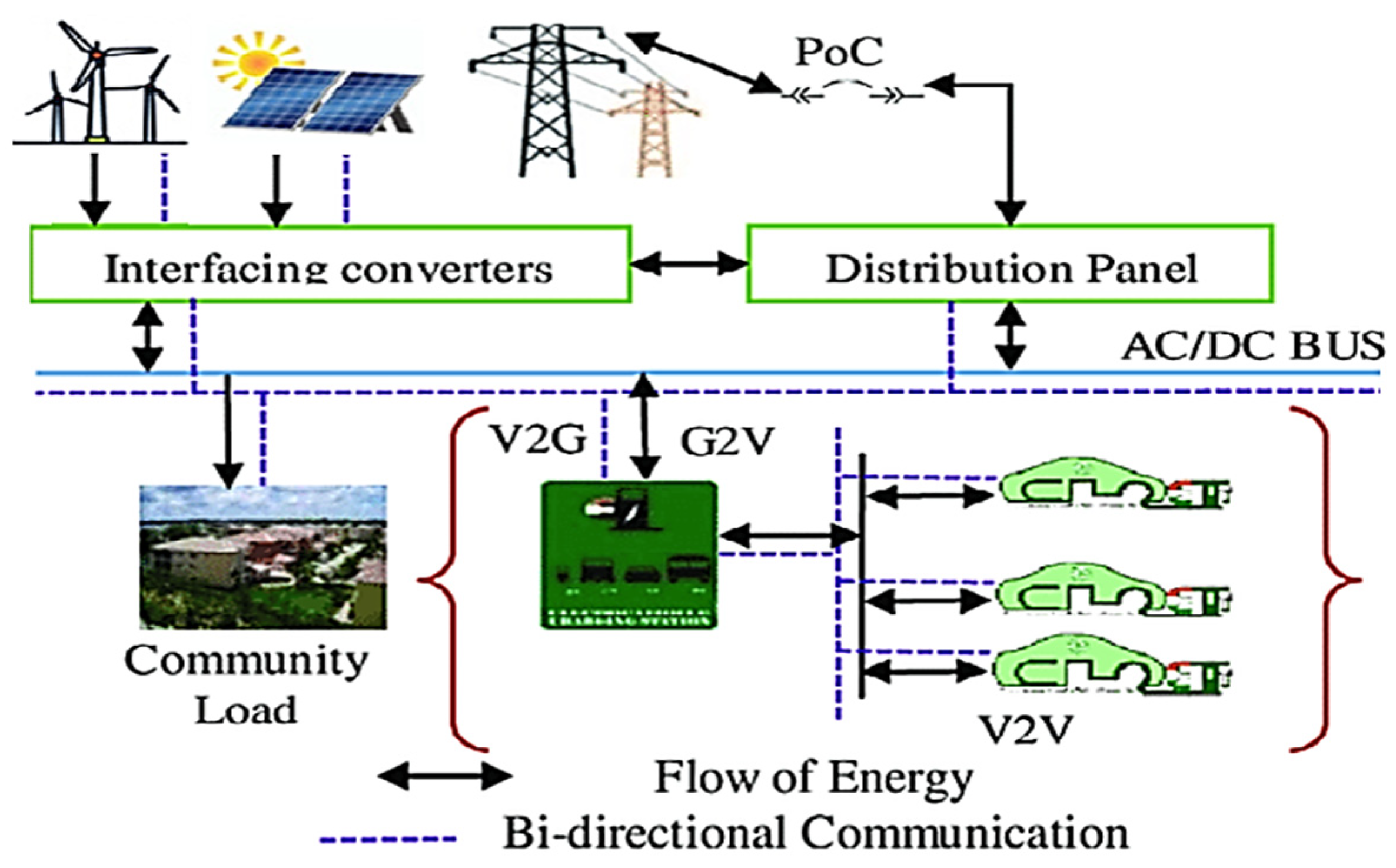
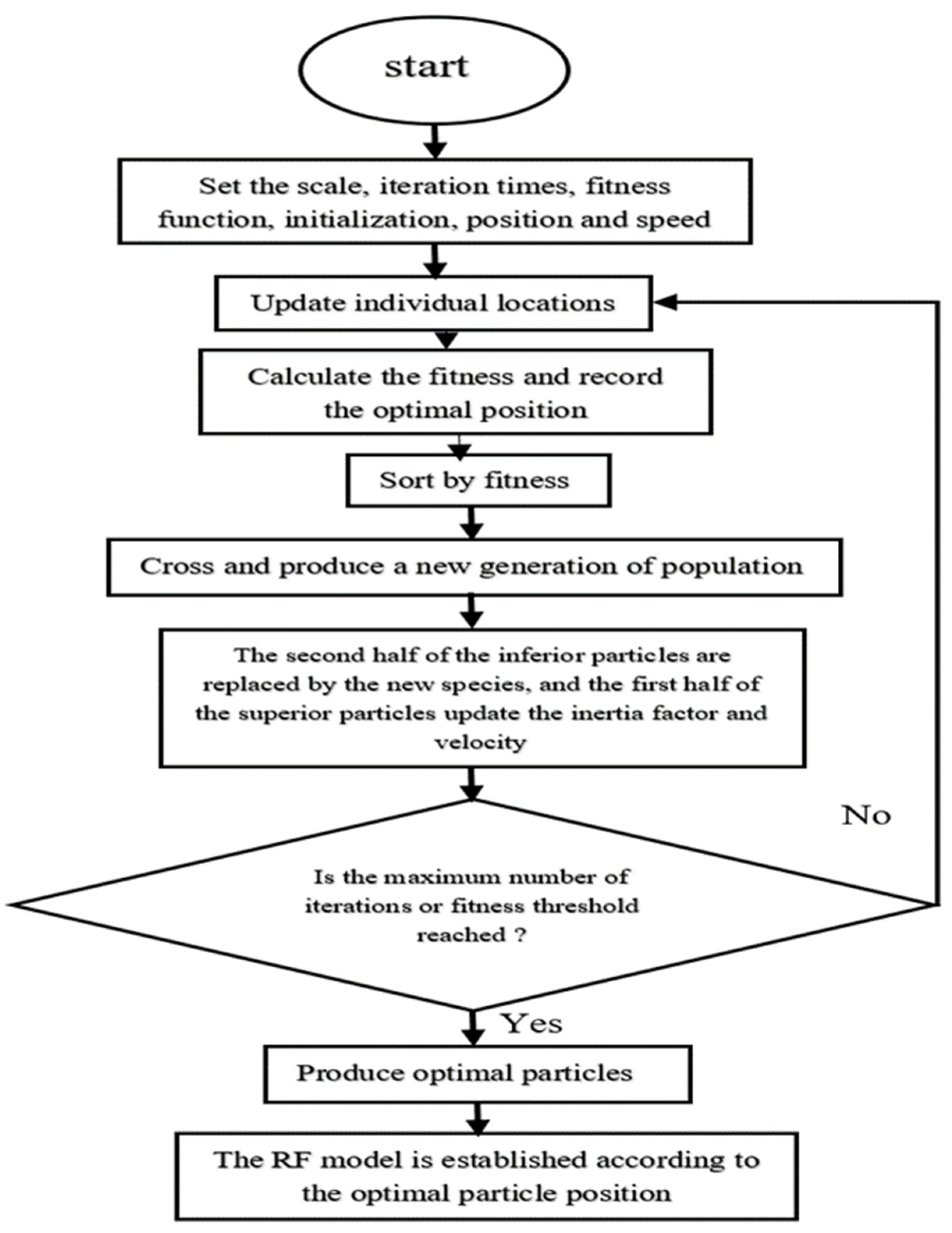
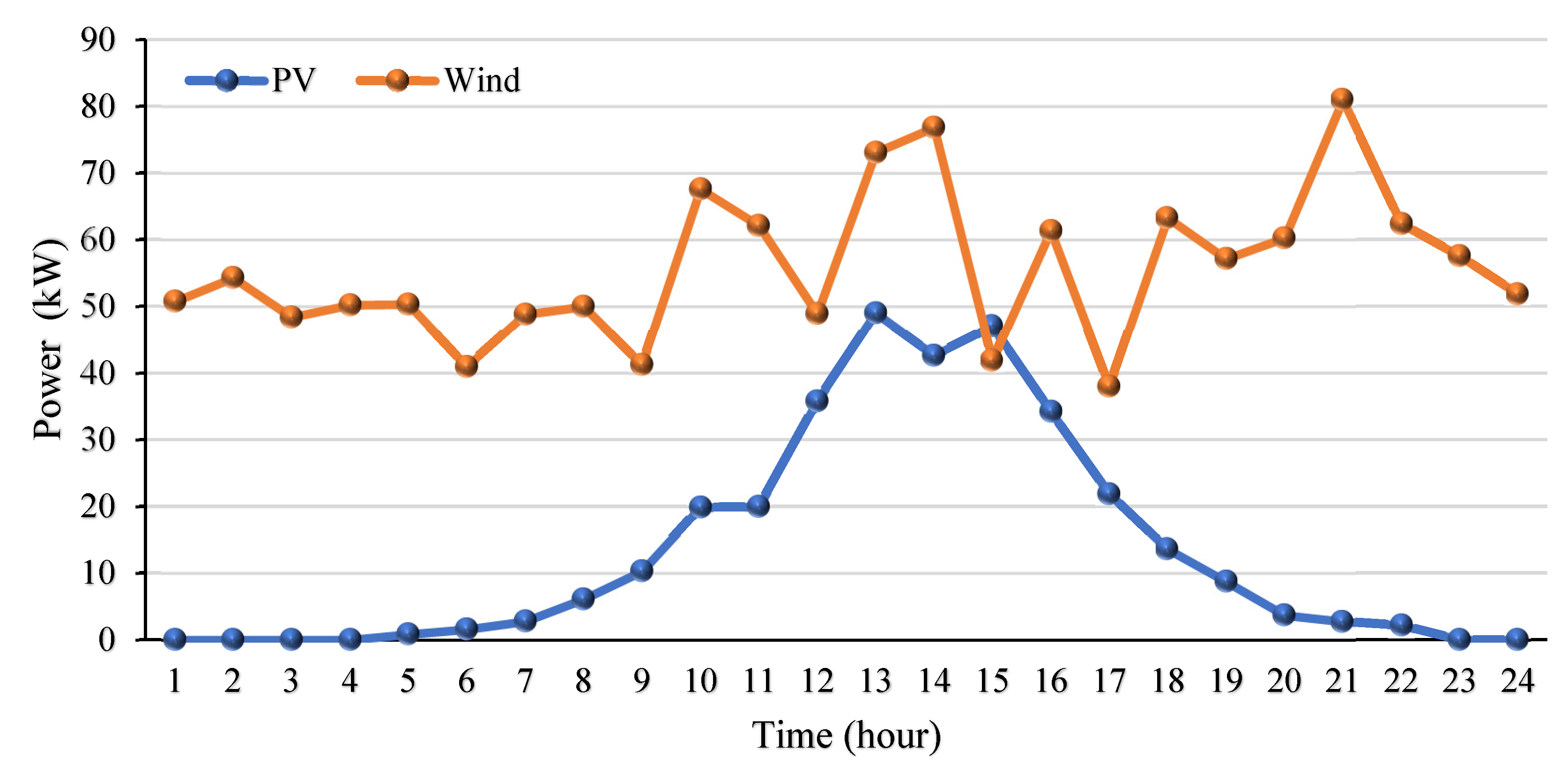
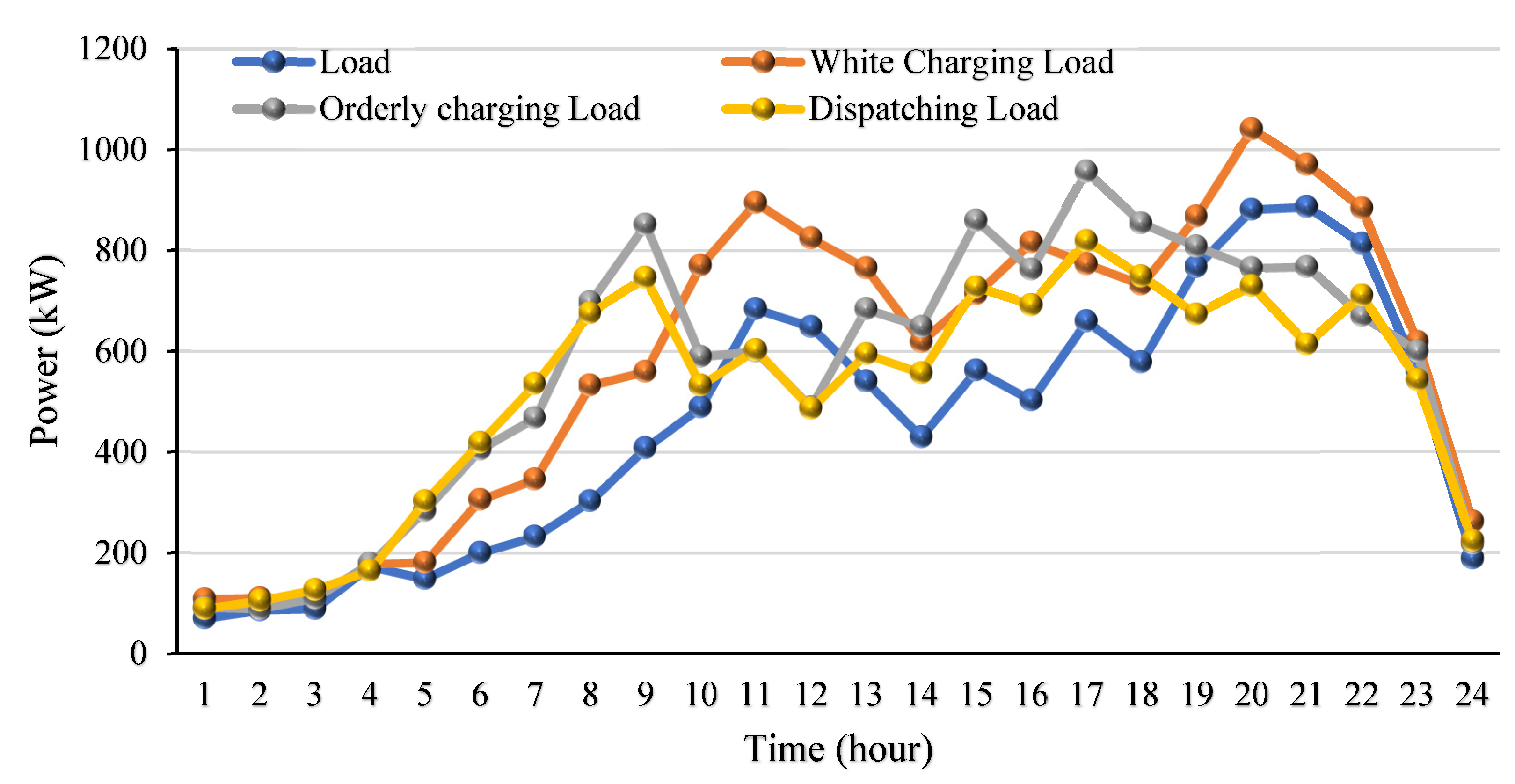
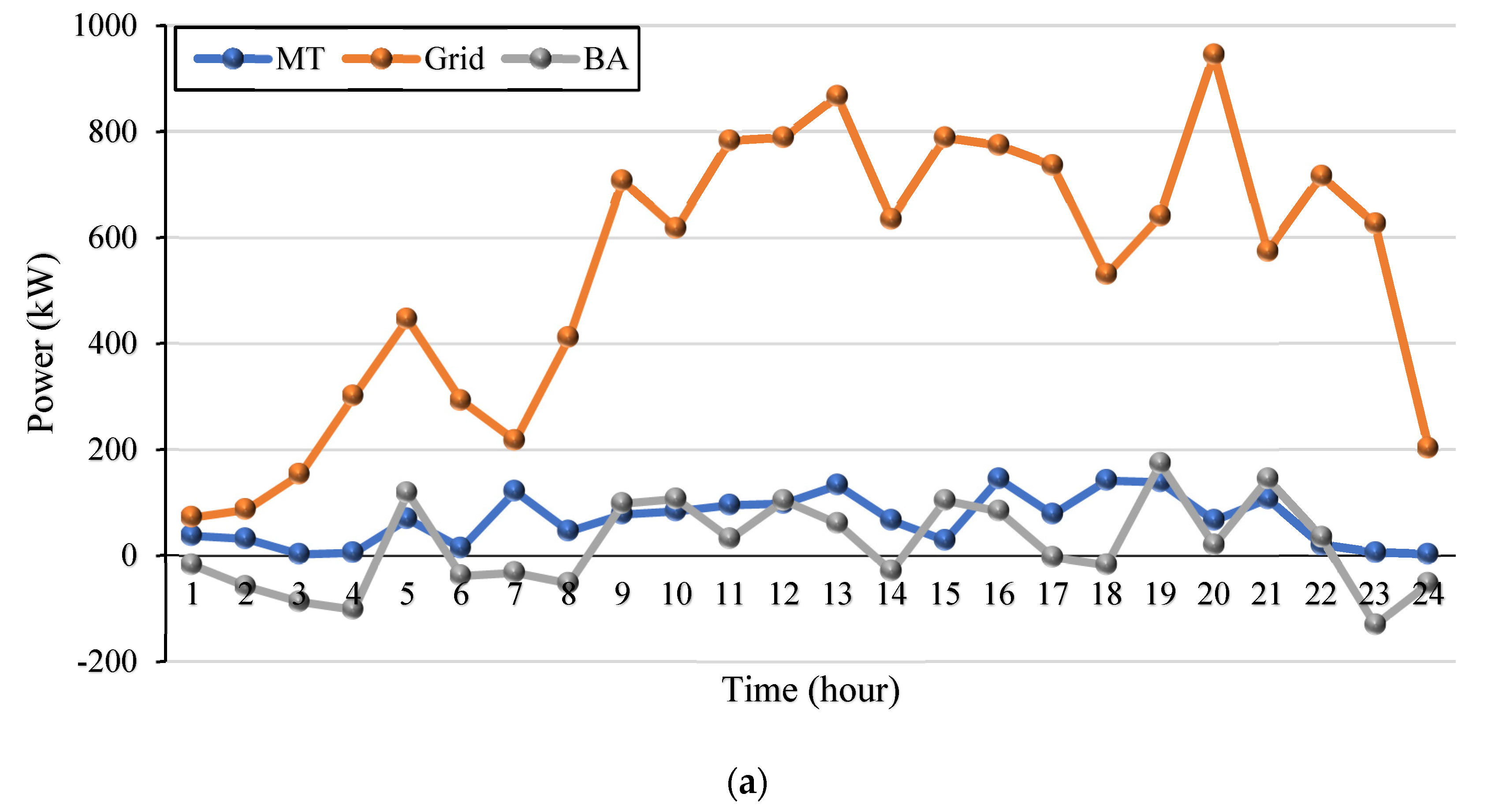
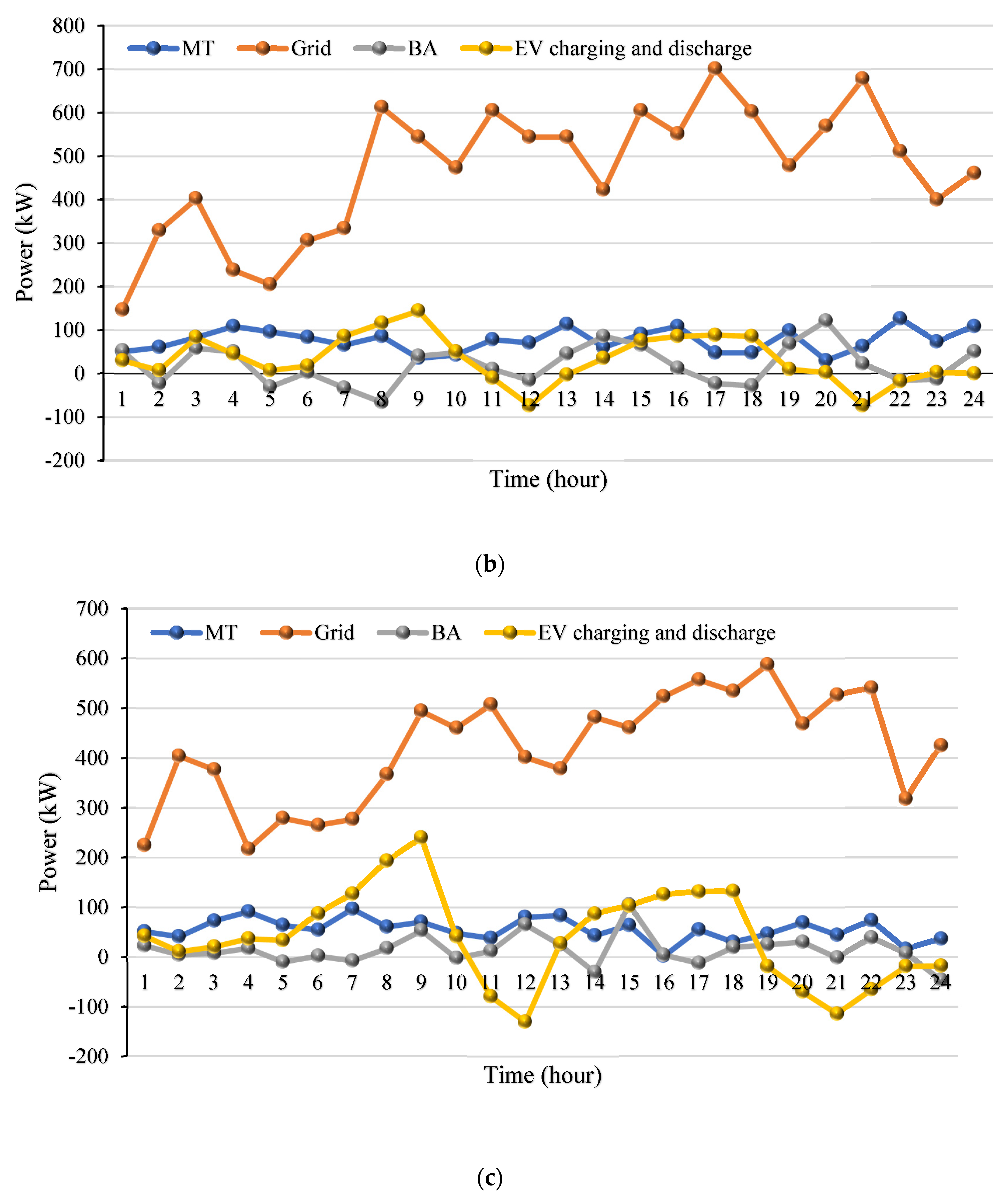
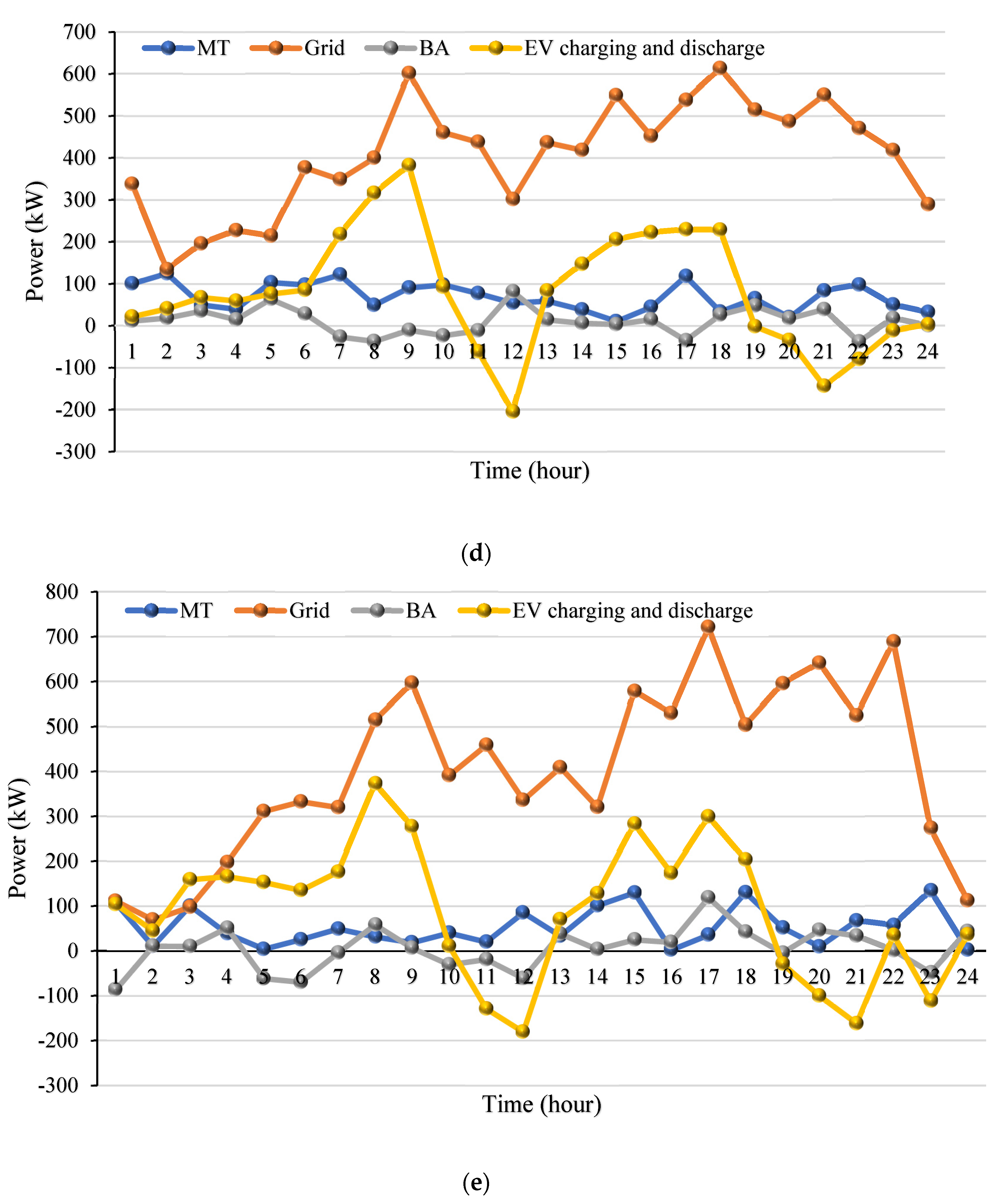
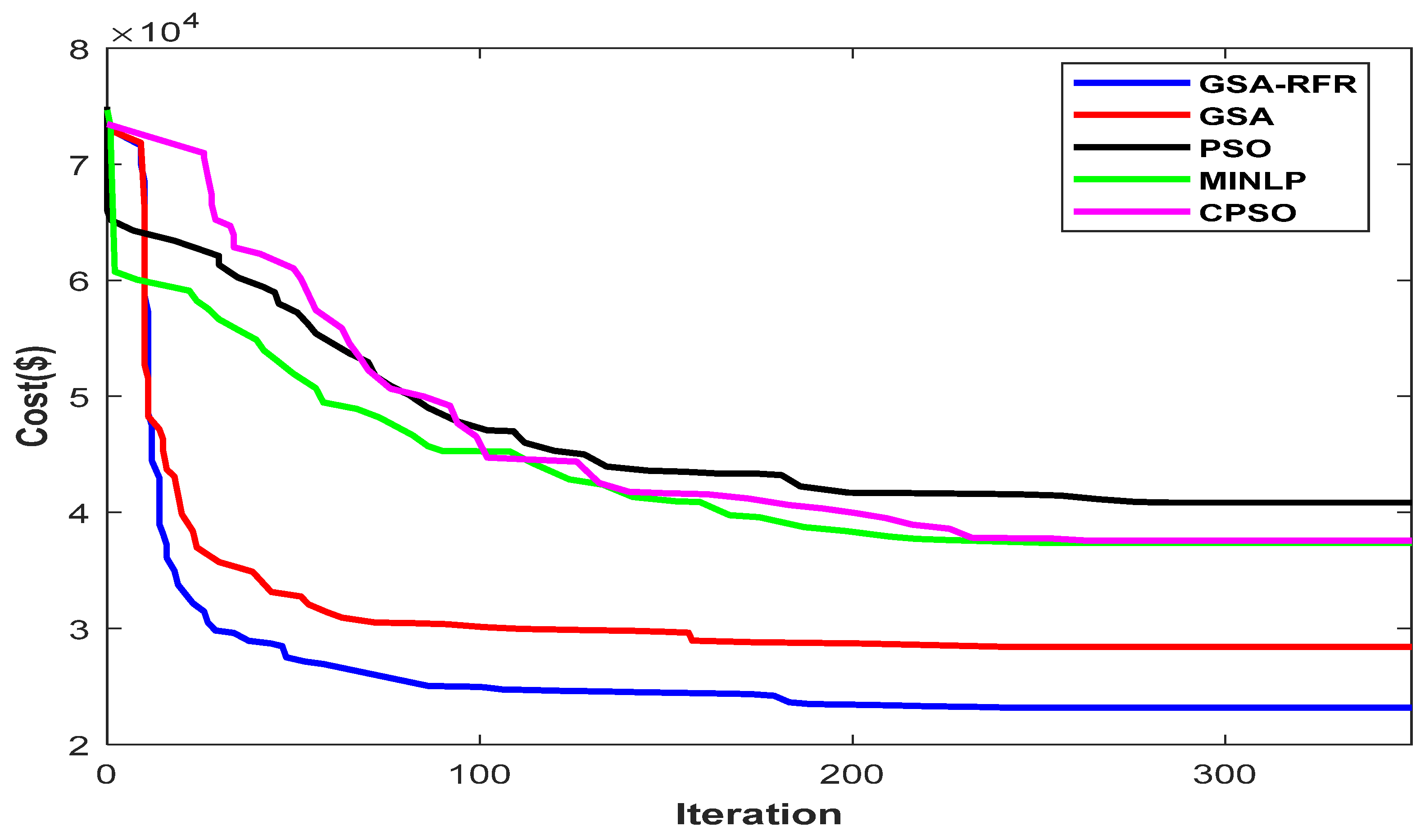
| Cases | Case1 | Case2 | Direct Current |
|---|---|---|---|
| Power (kW) | 1.4–3 | 5–10 | 25–180 |
| Resource | Power Range (kW) | Generation Cost (USD/kWh) | Maintenance Cost (USD/kWh) |
|---|---|---|---|
| BSS | −150~150 | 0.68 | 0.08439 |
| WT | 0.100~0.39 | 0.009 | 6 |
| PV | 0.75~0.56 | 0.001 | 2 |
| MT | 20~150 | 0.41 | 0.0401 |
| Contaminant Type | Control Costs (USD/kg) | Pollutant Emission Factor (kWh) | |||
|---|---|---|---|---|---|
| Grid | MT | WT | PV | ||
| CO2 | 0.21 | 889 | 724 | 0 | 0 |
| SO2 | 14.842 | 1.8 | 0.0036 | 0 | 0 |
| NOx | 62.94 | 41.6 | 0.2 | 0 | 0 |
| Period (Time) | Peak | Normal | Valley |
|---|---|---|---|
| 10:00–15:00 19:00–22:00 | 7:00–9:00 16:00–18:00 | 1:00–6:00 23:00–24:00 | |
| Electricity price (USD/kWh) | 1.56 | 0.7 | 0.43 |
| Purchase price (USD/kWh) | 0.75 | 0.43 | 0.14 |
| Category | Battery Capacity (kWh) | SOC Limit (%) | Charge and Discharge Power Limit (kW) | Charge and Discharge Efficiency (%) |
|---|---|---|---|---|
| Value | 52.5 | 20/90 | 50 | 0.95 |
| Weight Coefficient | MG Operation Costs (USD) | Environmental Pollution Costs (USD) | Load Fluctuation Variance |
|---|---|---|---|
| 1 | 94,099.872 | 10,735.098 | 12.56 |
| 2 | 42,739.869 | 8585.706 | 86.68 |
| 3 | 36,717.197 | 8081.684 | 118.62 |
| 4 | 31,347.512 | 7632.539 | 126.76 |
| 5 | 31,190.257 | 6976.039 | 285.38 |
| Responsiveness | MG Operating Costs (USD) | Environmental Pollution Treatment Costs (USD) | Load Fluctuation |
|---|---|---|---|
| 0% | 45,454.215 | 9467.724 | 253.71 |
| 30% | 37,967.285 | 8760.162 | 144.13 |
| 50% | 31,690.206 | 7881.186 | 114.24 |
| 80% | 28,655.759 | 7836.853 | 130.19 |
| 100% | 35,750.162 | 7972.188 | 196.15 |
| Algorithms | MG Operation Costs (USD) | Environmental Pollution Control Expenses (USD) | Variance of Load Fluctuation | Solution Running Time (s) |
|---|---|---|---|---|
| GSA-RFR | 48,974.386 | 8986.562 | 236.45 | 296.7 |
| GSA | 45,499.685 | 8654.639 | 214.32 | 307.5 |
| MINLP | 43,875.754 | 8579.546 | 196.53 | 314.3 |
| CPSO | 32,497.179 | 7608.743 | 184.65 | 375.6 |
| PSO | 28,785.478 | 6937.591 | 132.36 | 509.8 |
Publisher’s Note: MDPI stays neutral with regard to jurisdictional claims in published maps and institutional affiliations. |
© 2022 by the authors. Licensee MDPI, Basel, Switzerland. This article is an open access article distributed under the terms and conditions of the Creative Commons Attribution (CC BY) license (https://creativecommons.org/licenses/by/4.0/).
Share and Cite
Nazir, M.S.; Chu, Z.; Abdalla, A.N.; An, H.K.; Eldin, S.M.; M. Metwally, A.S.; Bocchetta, P.; Javed, M.S. Study of an Optimized Micro-Grid’s Operation with Electrical Vehicle-Based Hybridized Sustainable Algorithm. Sustainability 2022, 14, 16172. https://doi.org/10.3390/su142316172
Nazir MS, Chu Z, Abdalla AN, An HK, Eldin SM, M. Metwally AS, Bocchetta P, Javed MS. Study of an Optimized Micro-Grid’s Operation with Electrical Vehicle-Based Hybridized Sustainable Algorithm. Sustainability. 2022; 14(23):16172. https://doi.org/10.3390/su142316172
Chicago/Turabian StyleNazir, Muhammad Shahzad, Zhang Chu, Ahmad N. Abdalla, Hong Ki An, Sayed M. Eldin, Ahmed Sayed M. Metwally, Patrizia Bocchetta, and Muhammad Sufyan Javed. 2022. "Study of an Optimized Micro-Grid’s Operation with Electrical Vehicle-Based Hybridized Sustainable Algorithm" Sustainability 14, no. 23: 16172. https://doi.org/10.3390/su142316172
APA StyleNazir, M. S., Chu, Z., Abdalla, A. N., An, H. K., Eldin, S. M., M. Metwally, A. S., Bocchetta, P., & Javed, M. S. (2022). Study of an Optimized Micro-Grid’s Operation with Electrical Vehicle-Based Hybridized Sustainable Algorithm. Sustainability, 14(23), 16172. https://doi.org/10.3390/su142316172










